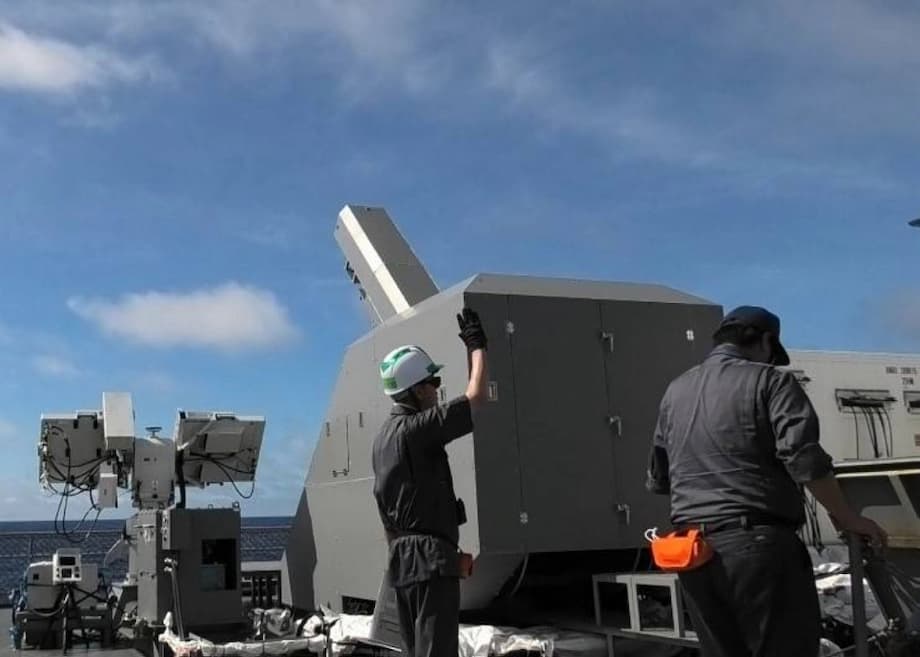A breakthrough test with regional stakes
Japan has taken a major step toward fielding an operational railgun at sea. The Ministry of Defense Acquisition, Technology and Logistics Agency (ATLA) confirmed that from June to early July, engineers fired a prototype electromagnetic railgun from the test ship JS Asuka at a target vessel during sea trials. The agency posted four images of the trial and said this marked the first time a ship mounted railgun has been fired at a real ship. The work was conducted with the support of the Japan Maritime Self Defense Force, whose experimental ship Asuka serves as a floating laboratory for new systems.
- A breakthrough test with regional stakes
- What exactly was tested at sea?
- How does a railgun work?
- What has Japan achieved so far?
- What could this weapon do in combat?
- How does the program compare with efforts in other countries?
- What comes next for Japan’s railgun?
- Risks, limits, and unanswered questions
- At a Glance
Railguns accelerate small metal projectiles using electricity, not chemical propellant. Two conductive rails and a sliding armature create a powerful magnetic field that pushes the projectile out of the barrel at extreme speed. The concept promises long range, high velocity shots at a cost per round far lower than guided missiles. A railgun does not need explosive warheads. It relies on raw kinetic energy, which reduces storage hazards and can expand a ship magazine compared to missile cells.
The June and July trial arrives at a time when Japan is investing in advanced defenses against an expanding missile arsenal in the region. Officials in Tokyo have highlighted railguns, high power microwave systems, and lasers as part of a layered air and missile defense plan. ATLA has said more technical details from the sea trials will be presented at a defense technology symposium in November. The government funded a research push on a future railgun in the current budget cycle. The goal is to mature a complete gun system that can fire multiple rounds in sequence, integrate with fire control, and stabilize projectiles in flight.
What exactly was tested at sea?
Asuka, a 151 meter research and development ship commissioned in 1995, carries the prototype railgun on its stern deck. Photos from the trial show a compact gunhouse, a visible support mast for sensors near the mount, and a muzzle velocity radar antenna. ATLA also fitted cameras, including one under the barrel, to study the moment of launch and to aid post shot analysis. The target was mounted on a small yard tug that sailed as a moving surface contact, with target boards visible in the imagery.
ATLA stated that the trial included long range firings and shooting at the target vessel. The agency did not publish footage of projectile impacts during this event. The shot data, sensor feeds, and video will feed a larger test program that began at land ranges and moved to sea in late 2023. The Fleet Research and Development Command of the maritime service supported the work, and senior officers visited Asuka during the spring to observe the installation before the ship departed Yokosuka for trials.
How does a railgun work?
A railgun uses the Lorentz force to accelerate a projectile. When a large pulse of current flows from one rail to the other through the armature behind the projectile, the interaction of the magnetic field and the current produces force along the rails. The energy is stored in large banks of capacitors or other pulse power modules and then released in milliseconds. Peak accelerations and currents are extreme, which creates engineering challenges.
Power and cooling
Ship integration depends on electrical power that can be generated and stored safely in a compact package. Continuous firing also requires fast recharge and heat removal. Thermal management is central because high current heats the rails and the armature path. Engineers must size power electronics, cabling, and cooling loops so that the gun can sustain multiple shots without severe performance loss. This is a central reason Asuka, which has space for test gear and large generators, is being used as the initial platform while smaller combatants would require a much more compact power solution.
Barrel life and materials
Unlike a gas gun, a railgun does not erode from blast pressure, but the rails and the contact surfaces take a beating from current, heat, and friction. ATLA reported that early barrels used copper rails and later adopted different rail materials. The agency has set a goal of reaching a barrel life of 120 rounds at a stable muzzle velocity. That work includes improvements to the armature that carries current, coatings on the rails, and projectiles that remain stable while they punch through dense air at high speed.
What has Japan achieved so far?
ATLA began full scale work on electromagnetic acceleration systems in 2016. Land based trials delivered successive milestones and the first firing from a ship in late 2023. In April this year, imagery showed the gun fully installed on Asuka before the sea period. The current prototype has a barrel about six meters in length with a bore around forty millimeters. In earlier shots, the team reported muzzle speeds in the region of two thousand to more than two thousand four hundred meters per second. Those velocities are near Mach seven at high altitude, though real sea level flight speeds depend on air density and projectile shape.
ATLA has shown a five megajoule shot in prior demonstrations and has discussed plans to raise stored energy toward twenty megajoules for future variants. The program is moving from single shot testing to continuous fire, where recharge, heat buildup, and stability become dominant engineering tasks. At sea, Asuka carried a dedicated fire control console next to the mount to tie the gun to ship sensors and to collect precise data such as measured muzzle velocity and projectile departure angle. This is visible in the photographs that accompanied the recent announcement.
Japanese industry is involved in the build and test campaign. Work cited by defense officials credits firms such as Japan Steel Works in fabrication, while ATLA leads design and trials. The program has also explored cooperation with the French German Research Institute of Saint Louis to exchange data and methods. All of these steps aim to mature a complete gun system that can be manufactured, maintained, and trained on real platforms.
What could this weapon do in combat?
A mature railgun could engage a wide set of targets. At sea, a ship crew could fire at small boats and remote controlled surface craft where missiles are too expensive to use. With the right projectile, the gun could deliver airburst fragments to defeat drones and cruise missiles. For ballistic or hypersonic threats that fly high and fast, a railgun would likely work in concert with missiles and sensors as part of a layered defense. The advantage is volume. A ship could carry hundreds of kinetic rounds and fire many shots in a short period, which is valuable against swarming threats.
Magazine depth and cost are central to the interest in this technology. Modern warships carry a fixed number of missile cells and cannot reload them at sea. Every time a ship engages a low cost drone with a high end interceptor, it spends millions of dollars and loses a cell that is difficult to replace during a long patrol. Railgun rounds are smaller, easier to store, and much cheaper per shot. That makes them attractive for long deployments and for the kind of repeated engagements seen in the Red Sea, where ships fired large numbers of interceptors to stop drones and missiles.
On land, a railgun could be used for counter battery fire, coastal artillery, or strikes against fixed sites at distances beyond conventional tube artillery. Research programs have studied projectiles that can release multiple tungsten sub projectiles at the endgame to increase hit probability against fast inbound targets. Designers are also testing guidance aids such as simple GPS receivers for mid course updates, although adding electronics to a projectile that experiences extreme acceleration is not a trivial task.
How does the program compare with efforts in other countries?
The United States Navy suspended its railgun effort in 2021 after spending hundreds of millions of dollars without fielding an operational system. The main obstacles were rail wear, severe heating, power needs, and the difficulty of building projectiles that could survive launch and still guide with precision. China has tested large railgun prototypes on river barges and has claimed progress in guidance, though there has been no public proof of an operational naval system. South Korea, Turkey, and European research institutes continue to investigate the technology.
Japan is out in front on real sea trials with a ship mounted railgun. By firing at a target vessel during fleet supported testing, ATLA has moved from laboratory demonstrations into maritime scenarios that look more like actual operations. The country is also integrating the work into a larger plan that includes new large combatants with abundant electrical power and the integration of sensors needed for track quality and shot control.
What comes next for Japan’s railgun?
ATLA has said it will share further data from the June and July firing series at a technical symposium in November. Officials have already laid out a research program that runs through fiscal year 2026 to deliver a complete gun system. The national budget for fiscal year 2024 set aside funding for research on a future railgun that can intercept airborne threats. The absence of a new line item in the next plan likely reflects a multi year appropriation that covers ongoing work.
The near term tasks include improving projectile flight stability, hardening rails and contact surfaces to maintain muzzle velocity across many shots, and refining the fire control system. The team is also focused on power supply miniaturization, because a compact generator and energy storage module is essential for installation on destroyers and future large Aegis equipped ships. Land based test beds will continue to fire developmental projectiles while Asuka supports shipboard integration, safety checks, and tactics development.
If progress stays on track, a production representative system could appear first on a large hull with substantial electrical reserves. Another path is a land based battery that feeds coastal defense missions. Either way, the ability to place many precise rounds on a bearing at high speed would add a new layer to Japan’s defense posture.
Risks, limits, and unanswered questions
Claims about range and lethality must be proven at sea against realistic targets that maneuver and arrive in numbers. Intercepting a cruise missile or a ballistic target requires reliable tracking, precise time of flight estimates, and a projectile that can survive launch, steer, and fuse at the right moment. Heating, plasma formation around the projectile, and atmospheric drag complicate this picture. The latest photos show attention to measurement with muzzle velocity radar and high speed cameras, but the program still has to demonstrate hits in demanding conditions.
Continuous firing is more than a power problem. Shock and heat change mechanical alignment and electrical contact across the rails. Even tiny changes can lower muzzle velocity or disturb projectile stability. A ship also has to manage electromagnetic compatibility so that a high current shot does not disrupt other sensitive systems. Safety is a consideration when storing large amounts of electrical energy aboard a crewed vessel. These are solvable engineering issues, but they will take time and iteration.
There is also the question of cost and industrial base. Railguns trade expensive missiles for cheaper rounds, but they do not eliminate logistics. A fleet must still produce, test, transport, and store many projectiles. Manufacturers need materials that can be made in quantity without rare inputs. Training, doctrine, and rules for when to use the railgun versus a missile must be refined to avoid wasting shots or over promising on what the gun can do in complex scenarios.
At a Glance
- ATLA fired a prototype railgun from JS Asuka at a target vessel during June to early July sea trials
- The agency said this was the first time a ship mounted railgun has been fired at a real ship
- Imagery shows a compact turret, a muzzle velocity radar, and cameras for data collection
- The target was mounted on a moving yard tug fitted with target boards
- Early trials achieved muzzle velocities around two thousand to more than two thousand four hundred meters per second
- ATLA has demonstrated a five megajoule shot and aims to scale toward twenty megajoules
- Program goals include continuous fire, a barrel life target of 120 rounds, and a dedicated fire control system
- Japan funded future railgun research in fiscal year 2024 at roughly 167 million dollars
- Further technical details are expected at a November technology symposium
- The United States halted its railgun effort in 2021, while Japan continues active sea testing
- Potential missions include defense against drones and cruise missiles, anti surface engagements, and coastal artillery roles




